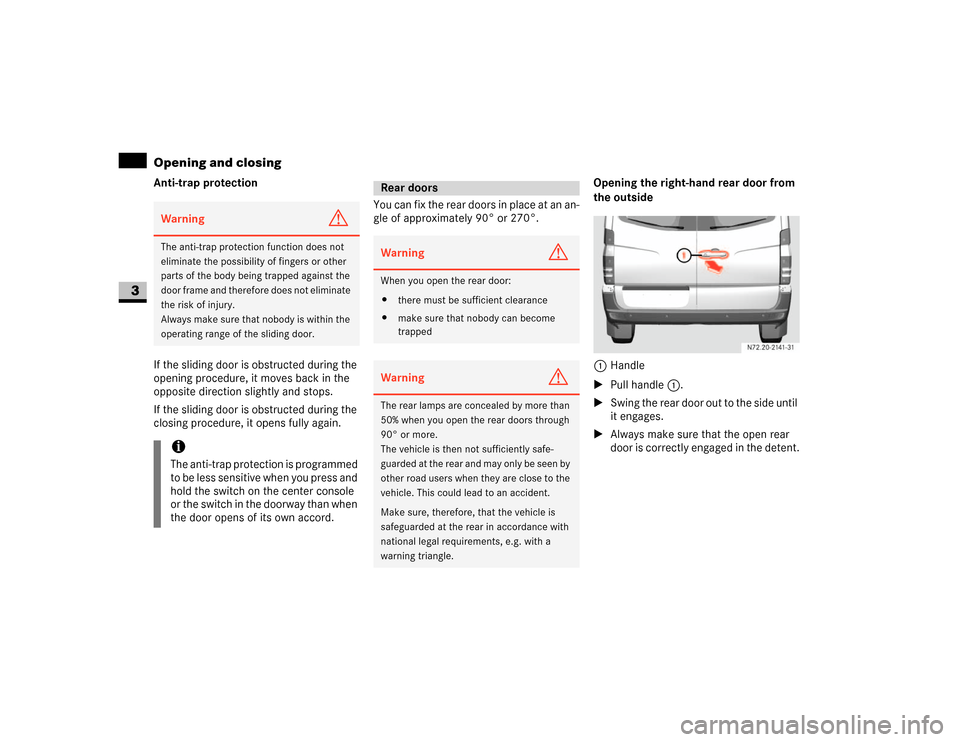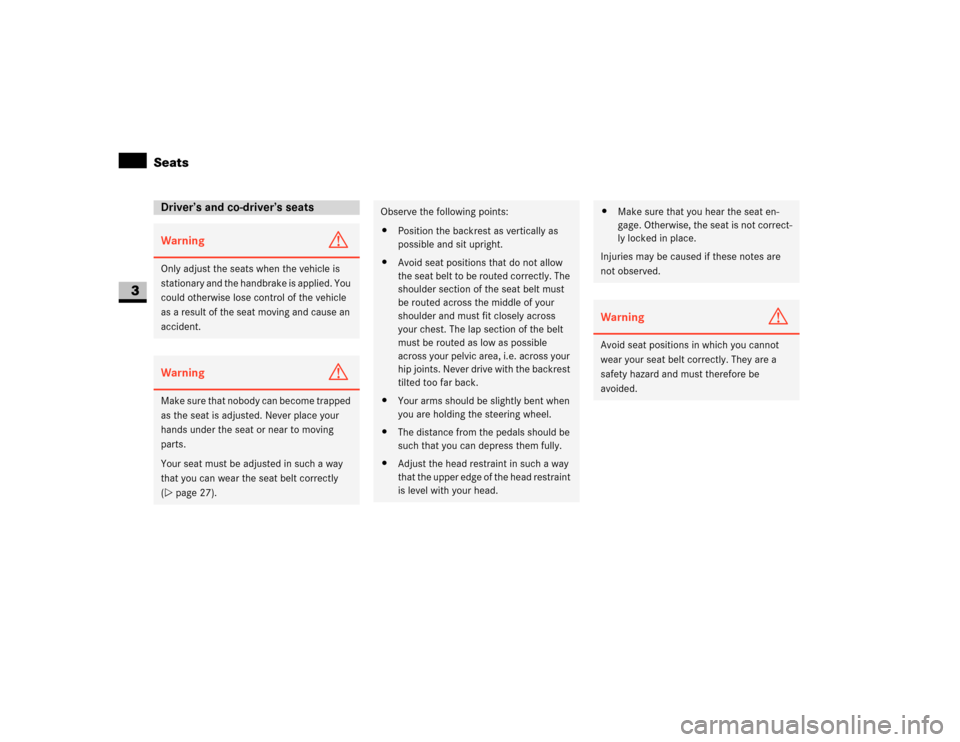2007 DODGE SPRINTER light
[x] Cancel search: lightPage 54 of 393

53 Controls in detail
Opening and closing
3
Remote control with key1 To unlock the sliding doors and
rear doors and opens or closes the
electric sliding door*
2ΠUnlocking button
3‹ Locking button
4Release button for mechanical key
5Battery check lamp.As a precaution, both remote controls
should always be carried.
Checking the batteries
\1Press theŒ or‹ button for
longer than 2 seconds.
The battery check lamp 5 comes on
briefly to indicate that the remote con-
trol batteries are in order.
Change the batteries immediately if the
lamp does not light up briefly during
check (\2page 315).
Warning
G
Do not leave children unsupervised in the
vehicle, even if they are secured by a child
restraint system.
The children could:
\4injure themselves on parts of the vehicle
\4unlock the door on vehicles with an elec-
tric sliding door by pressing the central
locking button, and then open the doors
and thereby injure other persons
\4get out of the vehicle and could either
injure themselves when doing so or they
could be injured by passing vehicles
\4be severely or even fatally injured by
prolonged exposure to intense heat
!Do not expose the key to high levels of
electromagnetic radiation, otherwise
this may interfere with the functions of
the key.
Protect the key from moisture to pre-
vent malfunctions.
iTo prevent theft, only use the remote
control in the immediate vicinity of the
vehicle.
In an emergency, the driver’s door and
rear door can also be unlocked manual-
ly using the key.iIf the batteries are checked within
signal range of the vehicle, pressing the
Œ or‹ button will lock or un-
lock the vehicle accordingly.
Page 59 of 393

58 Controls in detailOpening and closing
3
Sliding door switch in the doorway3To open / close the sliding door
\1To open the sliding door: briefly press
lower part 2 of the switch on the cen-
ter console.
\1The indicator lamp in the switch flash-
es. The sliding door unlocks and opens,
and a signal sounds.
or
\1Briefly press switch3 in the doorway.The sliding door unlocks.
\1Briefly press switch3 in the doorway
again.
The indicator lamp in the switch flash-
es. The sliding door opens and a signal
sounds.
\1To close the sliding door: briefly
press upper part 1 of the switch on
the center console or briefly press
switch 3 in the doorway.
The indicator lamp in the switch flash-
es. The sliding door closes and a signal
sounds.
\1Press lower/upper part of the switch
on the center console or press
switch3 in the doorway.
The sliding door stops.
\1To lock the sliding door from inside:
press the locking knob of the sliding
door down (\2page 56).Proceed as follows in the event of unfavor-
able operating conditions, e.g. frost, ice or
heavy soiling:
\1To open the sliding door: press lower
part 2 of the switch on the center con-
sole or press and hold switch3 in the
doorway.
The indicator lamp in the switch flash-
es. The sliding door unlocks and opens,
and a signal sounds.
\1To close the sliding door: press upper
part 1 of the switch on the center con-
sole or press and hold switch3 in the
doorway.
The indicator lamp in the switch flash-
es. The sliding door closes and a signal
sounds.
\1Release the switch.
The sliding door stops.
iOn vehicles with a partition, the switch
is located on the partition near the
doorway level with the inside door han-
dle.N72.16-2119-31
iThe indicator lamp in the switch on the
center console lights up whenever the
sliding door is open.
Page 61 of 393

60 Controls in detailOpening and closing
3
Anti-trap protection
If the sliding door is obstructed during the
opening procedure, it moves back in the
opposite direction slightly and stops.
If the sliding door is obstructed during the
closing procedure, it opens fully again.You can fix the rear doors in place at an an-
gle of approximately 90° or 270°.Opening the right-hand rear door from
the outside
1Handle
\1Pull handle 1.
\1Swing the rear door out to the side until
it engages.
\1Always make sure that the open rear
door is correctly engaged in the detent.Warning
G
The anti-trap protection function does not
eliminate the possibility of fingers or other
parts of the body being trapped against the
door frame and therefore does not eliminate
the risk of injury.
Always make sure that nobody is within the
operating range of the sliding door.iThe anti-trap protection is programmed
to be less sensitive when you press and
hold the switch on the center console
or the switch in the doorway than when
the door opens of its own accord.
Rear doorsWarning
G
When you open the rear door:
\4there must be sufficient clearance
\4make sure that nobody can become
trappedWarning
G
The rear lamps are concealed by more than
50% when you open the rear doors through
90° or more.
The vehicle is then not sufficiently safe-
guarded at the rear and may only be seen by
other road users when they are close to the
vehicle. This could lead to an accident.
Make sure, therefore, that the vehicle is
safeguarded at the rear in accordance with
national legal requirements, e.g. with a
warning triangle.
Page 64 of 393

63 Controls in detail
Opening and closing
3
\1To close: make sure that the left-hand
rear door is closed.
\1Pull the right-hand rear door firmly
closed by the door handle.
\1To lock: slide catch2 to the right.
Only the rear door is locked.
The white marking is no longer visible.Using the central locking switch, you can
centrally lock or unlock from the inside ei-
ther the entire vehicle or the sliding doors
and rear doors only.The central locking switch is located on the
center console.
1To lock / unlock the entire vehicle
2To lock / unlock the sliding doors and
rear doorWarning
G
M a k e s u r e t h a t n o b o d y c a n b e c o m e t r a p p e d
as you close the rear door.
Locking and unlocking centrally
from the insideWarning
G
Do not leave children unsupervised in the
vehicle, even if they are secured by a child
restraint system. The children could:
\4injure themselves on parts of the vehicle
\4be severely or even fatally injured by
prolonged exposure to intense heat
If the children open a door, they could:
\4cause injury to others as a result
\4get out of the vehicle and could either
injure themselves when doing so or they
could be injured by passing vehicles
\4sustain serious injuries if they were to
fall out of the vehicle, due in particular
to the height of the passenger compart-
ment from the ground
iIf the key is in position0 or no longer in
the ignition lock, the indicator lamp in
the central locking switch lights up for
5 seconds after it is pressed. It lights
up permanently if the key is in position
1 or2 in the ignition lock.
N54.25-2917-31
Page 68 of 393

67 Controls in detail
Key positions
3
\3 Key positions0 To remove the key, to lock the steering
wheel
1 To unlock the steering wheel (power
supply for some consumers, e.g. radio)
2 To switch on the ignition (power supply
for all consumers)
Preglow
1 and drive position
3 To start
1 Only vehicles with a diesel engine
iThe key can only be removed from
position0. Also observe the notes in
the “Driving and parking” section
(\2page 110).
To unlock the steering, turn the steer-
ing wheel slightly while turning the key
to position 1.
On vehicles with a battery isolating
switch, you must first switch on the
electrical system (\2page 198).
Page 69 of 393

68 Controls in detailSeats
3
Driver’s and co-driver’s seatsWarning
G
Only adjust the seats when the vehicle is
stationary and the handbrake is applied. You
could otherwise lose control of the vehicle
as a result of the seat moving and cause an
accident.Warning
G
Make sure that nobody can become trapped
as the seat is adjusted. Never place your
hands under the seat or near to moving
parts.
Your seat must be adjusted in such a way
that you can wear the seat belt correctly
(\2page 27).
Observe the following points:
\4Position the backrest as vertically as
possible and sit upright.
\4Avoid seat positions that do not allow
the seat belt to be routed correctly. The
shoulder section of the seat belt must
be routed across the middle of your
shoulder and must fit closely across
your chest. The lap section of the belt
must be routed as low as possible
across your pelvic area, i.e. across your
hip joints. Never drive with the backrest
tilted too far back.
\4Your arms should be slightly bent when
you are holding the steering wheel.
\4The distance from the pedals should be
such that you can depress them fully.
\4Adjust the head restraint in such a way
that the upper edge of the head restraint
is level with your head.
\4Make sure that you hear the seat en-
gage. Otherwise, the seat is not correct-
ly locked in place.
Injuries may be caused if these notes are
not observed.Warning
G
Avoid seat positions in which you cannot
wear your seat belt correctly. They are a
safety hazard and must therefore be
avoided.
Page 70 of 393

69 Controls in detail
Seats
3
Standard, comfort* and suspension
seats*
1Seat fore-and-aft adjustment
2Lumbar support adjustment
3Backrest adjustment
4Seat height adjustment
5Seat angle adjustment
6Seat suspension adjustment
7Vertical lock leverSeat fore-and-aft adjustment
\1Pull lever 1 up.
\1Slide the seat forwards or backwards
until you can reach the pedals and de-
press them.
\1Release lever1.
\1Slide the seat forwards or backwards
slightly until it engages audibly.
Backrest adjustment
\1Turn thumbwheel3 forward.
The backrest moves to an upright posi-
tion.
\1Turn thumbwheel3 backward.
The backrest tilts towards the rear.
Seat height adjustment
\1Push or pull lever4 repeatedly until
you have reached the desired seat
height.Seat angle adjustment*
\1Turn thumbwheel5 forward.
The front of the seat cushion tilts down.
\1Turn thumbwheel5 backward.
The front of the seat cushion tilts up.
Lumbar support adjustment*
\1Turn thumbwheel2 upward.
This increases the support provided to
your lumbar region.
\1Turn thumbwheel2 downward.
This reduces the support provided to
your lumbar region.
iDifferent settings are possible, depend-
ing on the seat version.
iUsing the lumbar support, you can in-
crease the level of support that the
backrest provides to your spinal col-
umn.
When the lumbar support is correctly
adjusted, it reduces strain on your back
while you are driving.
Page 72 of 393

71 Controls in detail
Seats
3
The seat release lever is located behind the
seat between the seat backrest and the
seat base.Co-driver’s seat\1Press lever 1 on the back of the seat
to the middle and turn the seat slightly
inwards.
\1The turning device is unlocked.
\1Release lever 1 again.
\1Turn the seat inwards to the desired
position.Twin co-driver's seat*Folding the seat cushion forward
1To release from the front anchorage
2To release from the rear anchorage
\1Lift the seat cushion out of front
anchorage1.
\1Pull the seat cushion towards the front
slightly and out of rear anchorage2.
\1Fold the seat cushion up by the rear
edge. 1Lever
Warning
G
You could knock yourself against the unpro-
tected pivoting frame if the seat is opposite
of the direction of travel and pushed right
back in a longitudinal direction.Therefore, center the seat above the seat
base whenever you leave it. Point out this
danger to passengers.iThe twin co-driver’s seat does not pro-
vide the same level of comfort as the
driver’s and co-driver’s seats.
There is only restricted seat width and
legroom.
iYou can store various articles in the
space under the twin co-driver’s seat.